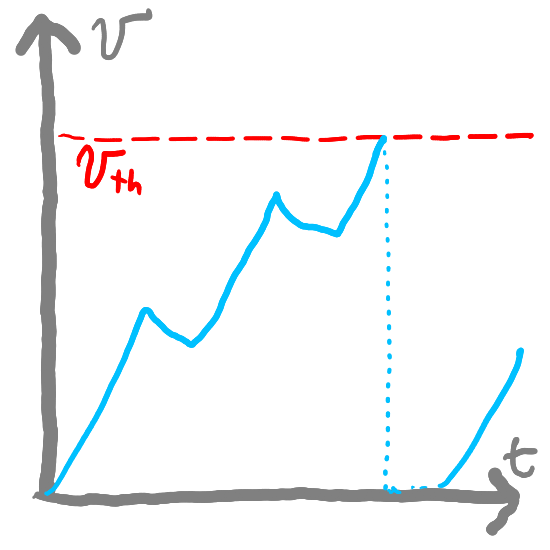Firing Rates and Tuning Curves#
One way to summarize the important aspects of what a neuron “does” is to summarize how it responds to a variety of inputs. We’re going to use the LIF model from before:
class FirstOrderLIF: # First Order Leaky Integrate and Fire
def __init__(self, tau_rc=0.2, tau_ref=0.002, v_init=0, v_th=1):
self.tau_rc = tau_rc # Potential decay time constant
self.v = v_init # Potential value
self.v_th = v_th # Firing threshold
self.tau_ref = tau_ref # Refractory period time constant
self.output = 0 # Current output value
self.refractory_time = 0 # Current refractory period time (how long until the neuron can fire again)
def step(self, I, t_step): # Advance one time step (input I and time step size t_step)
self.refractory_time -= t_step # Subtract the amount of time that passed from our refractory time
if self.refractory_time < 0: # If the neuron is not in its refractory period
self.v = self.v * (1 - t_step / self.tau_rc) + I * t_step / self.tau_rc # Integrate the input current
if self.v > self.v_th: # If the potential is above the threshold
self.refractory_time = self.tau_ref # Enter the refractory period
self.output = 1 / t_step # Emit a spike
self.v = 0 # Reset the potential
else: # If the potential is below the threshold
self.output = 0 # Do not fire
return self.output
So let’s see what happens if we input a constant current. We’re going to create a LIF neuron with parameters \(\tau_{rc} = 0.02\) and \(\tau_{ref} = 0.2\) and plot the spikes of our LIF neuron given a constant inputs of varying intensities.
Let’s see what happens when we call our function with an input slightly over 1A (1.0000001):
Show code cell source
import numpy as np
import matplotlib.pyplot as plt
def fullPlot(I):
duration = 20 # Duration of the simulation
T_step = 0.001 # Time step size
times = np.arange(1, duration, T_step) # Create a range of time values
neuron = FirstOrderLIF(tau_ref = 0.2) # Create a new LIF neuron
I_history = []
v_history = []
output_history = []
vth_history = []
for t in times: # Iterate over each time step
neuron.step(I, T_step) # Advance the neuron one time step
I_history.append(I) # Record the input current
v_history.append(neuron.v) # Record the neuron's potential
output_history.append(neuron.output * T_step / 10) # Record the neuron's output (scaled)
vth_history.append(neuron.v_th) # Record the neuron's threshold
plt.figure() # Create a new figure
plt.plot(times, I_history, color="grey", linestyle="--")
plt.plot(times, vth_history, color="green", linestyle="--")
plt.plot(times, v_history)
plt.plot(times, output_history, color="red", linewidth=2.5)
plt.xlabel('Time (s)') # Label the x-axis
plt.legend(['Input current', 'neuron.v_th', 'neuron.v', 'neuron.output']) # Add a legend
plt.show() # Display the plot
fullPlot(1.1) # Run the simulation with an input current of 1.1
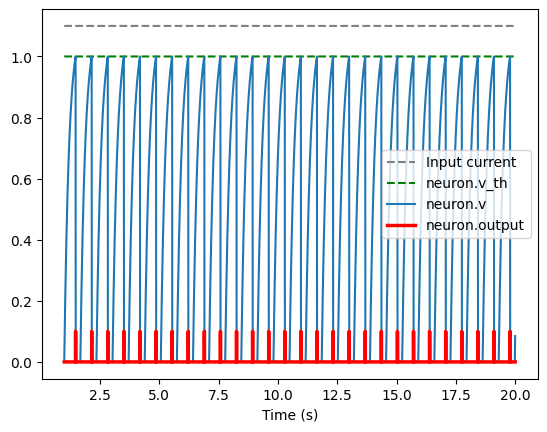
If we don’t have sufficient input (for example, if I is 0.95), our neuron never fires
Show code cell source
fullPlot(I = 0.95)
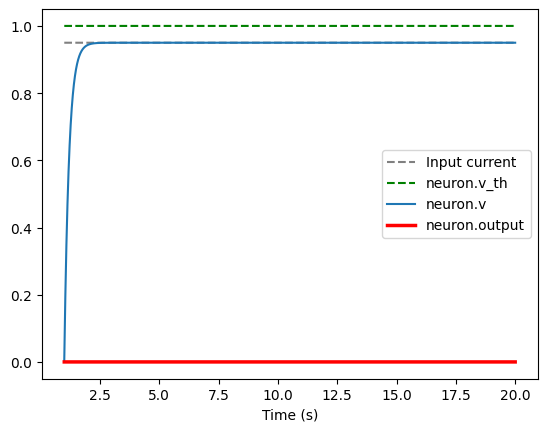
We don’t really need to see anything but the spikes, so let’s create a different view of these with only the spikes. If we put our input I to be barely above 1 (to 1.0000001), our neuron will fire again:
Show code cell source
import matplotlib.pyplot as plt
def plotSpikes(neuron, duration, t_step, input_current):
# Lists to record spike times and membrane potential
spike_times = []
time_points = []
# Run the simulation
time = 0.0
while time < duration:
output = neuron.step(input_current, t_step)
time_points.append(time)
if output > 0: # neuron fires a spike
spike_times.append(time)
time += t_step
# Plot the spikes as vertical lines
plt.figure(figsize=(7, 0.3))
for spike_time in spike_times:
plt.axvline(x=spike_time, color='red', linewidth=0.5)
plt.axis('off') # Turn off the axes
# Calculate and display the output message
num_spikes = len(spike_times)
spike_rate = num_spikes / duration
output_message = f"An input of {input_current} produces {num_spikes} spikes in {duration} seconds ({spike_rate:.2f} Hz)"
plt.show()
return output_message
plotSpikes(FirstOrderLIF(tau_rc=0.02, tau_ref=0.2), duration=20, t_step=0.001, input_current=1.0000001)

'An input of 1.0000001 produces 39 spikes in 20 seconds (1.95 Hz)'
We can see that our neuron fires about twice per second, making its firing rate ~2Hz. If we increase our input to 1.1, we can see that it fires more frequently:
Show code cell source
plotSpikes(FirstOrderLIF(tau_rc=0.02, tau_ref=0.2), duration=20, t_step=0.001, input_current=1.1)

'An input of 1.1 produces 82 spikes in 20 seconds (4.10 Hz)'
Increase it some more (to 10), and it will fire even more frequently.
Show code cell source
plotSpikes(FirstOrderLIF(tau_rc=0.02, tau_ref=0.2), duration=20, t_step=0.001, input_current=10)

'An input of 10 produces 99 spikes in 20 seconds (4.95 Hz)'
But we can only increase it so much, thanks to the refractory time. If we increase our incoming current significantly (to 100), our spike frequency barely changes:
Show code cell source
plotSpikes(FirstOrderLIF(tau_rc=0.02, tau_ref=0.2), duration=20, t_step=0.001, input_current=100)

'An input of 100 produces 100 spikes in 20 seconds (5.00 Hz)'
However, if we don’t input enough current, our neuron never spikes, as the potential leaks out faster than it can be added.
Show code cell source
plotSpikes(FirstOrderLIF(tau_rc=0.02, tau_ref=0.2), duration=20, t_step=0.001, input_current=0.8)

'An input of 0.8 produces 0 spikes in 20 seconds (0.00 Hz)'
As we can see, different inputs lead to different spike frequencies. We can plot this relationship between input and output as a graph, which is called a tuning curve. Let’s plot the tuning curve of our neuron, where the x-axis is the input current and the y-axis is the output firing rate:
def getSpikeRate(neuron, I, numSeconds=10, T_step=0.001):
"""
Get the spike rate of a neuron for a given input current
"""
count = 0 # Will store the number of spikes
numSteps = int(numSeconds / T_step) # How many times we need to call step()
for _ in range(numSteps):
output = neuron.step(I, T_step)
if output > 0: # If the neuron fired a spike, add it to our cou nt
count += 1
return count / numSeconds # To get the *rate*, divide by the number of seconds
inputs = np.arange(0, 10.1, 0.1) # Create a range of input values (0 to 10.1)
output_rates = []
for inp in inputs: # Iterate over each input value
output_rate = getSpikeRate(FirstOrderLIF(tau_rc=0.3, tau_ref=0.2), inp) # Get the spike rate for that input
output_rates.append(output_rate) # Store the output rate
plt.figure() # Create a new figure
plt.plot(inputs, output_rates) # Plot the input rates
plt.xlabel('Input current') # Label the x-axis
plt.ylabel('Output rate') # Label the y-axis
plt.show() # Display the plot
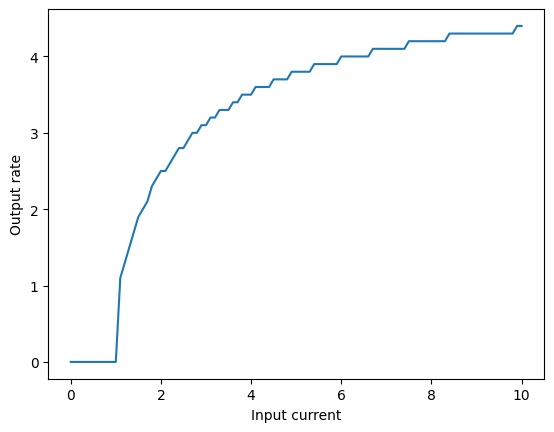
In the code above, we calculated the output rate with the getSpikeRate function, which “runs” the neuron with a given input to get the spike rate for input \(I\), \(r(I)\):
How did we get this formula?
(Optional) Analytically Computing LIF Responses
Recall our equation defining \(v'(t)\) (2):
When we have a function whose rate of change is proportional to its value (as \(v(t)\) is), we call it an exponential function. For example, \(e^x\) is an exponential function because its derivative is itself: \(\frac{de^x}{dx} = e^x\). In this case, \(v(t)\) decays exponentially (as opposed to growing exponentially), which is the case when \(x < 0\).
So generally, whenever we have a rate of change of something (in this case, \(v'(t)\)) that is proportional to the thing itself (in this case, \(v(t)\)), there’s a good chance that the solution involves either \(e^{...}\) or \(sin(...)\), whose derivatives are proportional to themselves (and are related by Euler’s formula). Coming back to our function, one definition of \(v(t)\) that satisfies our constraints is:
If we want to compute the time that it takes to get from \(v = 0\) to the firing threshold \(v = v_{th}\) under a constant input current \(I\), we first need to assume that the input current is high enough: \(I > v_{th}\). Then, we can solve for how long it takes to reach \(v_{th}\) (which we will call \(t_{th}\)), we can sub in \(t_{th}\) for \(\Delta{}t\), \(0\) for \(v(t)\), and \(v_{th}\) for \(v(t)\) in the above formula:
Moving terms around, we get:
giving us:
To compute the time that it takes to fire and recover, we need to add the refractory time (\(\tau_{ref}\)). This means the time that it takes to fire is:
and to get the firing rate \(r(I)\) for a given input \(I\), we take its inverse:
However, all of this only applies if \(I > v_{th}\), leaving us with the final equation:
import numpy as np
def analyticalRate(neuron, I):
if I <= neuron.v_th:
return 0
else:
return 1 / (neuron.tau_ref - neuron.tau_rc * np.log(1 - neuron.v_th/I))
plt.figure() # Create a new figure
plt.plot(inputs, output_rates) # Plot the input rates
plt.plot(inputs, [analyticalRate(FirstOrderLIF(tau_rc=0.3, tau_ref=0.2), I) for I in inputs], color="C1", linestyle="--") # Plot the analytical rates
plt.xlabel('Input current') # Label the x-axis
plt.ylabel('Output rate') # Label the y-axis
plt.legend(['Simulated', 'Analytical']) # Add a legend
plt.show() # Display the plot
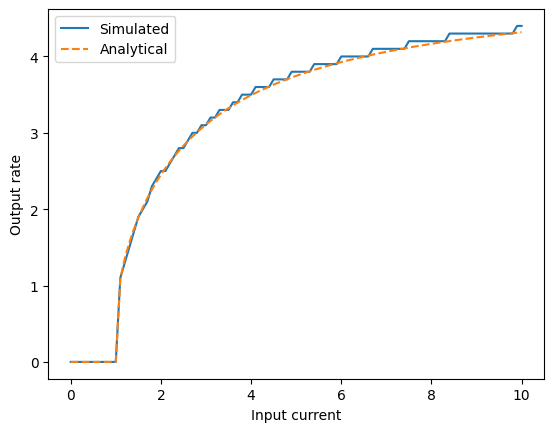
This looks like a good match! The firing rate that we computed analytically matches what we observe in the simulation.
Now, try modifying the LIF parameters below (tau_ref, tau_rc, and v_th) and see how the tuning curve changes.
So we can see that our neuron does not react to current until it reaches \(v_{th}\). At that point, it starts firing and its firing rate is proportional to the incoming current. The firing rate eventually flattens out, thanks to the refractory time (the period where the neuron can’t fire).
Summary#
A tuning curve summarizes a neuron’s response (in the form of a firing rate) to a variety of inputs
Neurons start firing at the threshold potential \(v_{th}\) and the firing rate rises as the input increases (but rises at a decreasing rate)
As long as there is some refractory time, our neuron’s firing rate will “flatten” out to a maximum value
References#
Chris Eliasmith’s Neural Engineering book contains the derivation used for analytically computing LIF responses
The Nengo summer school lectures clearly describe how tuning curves work
